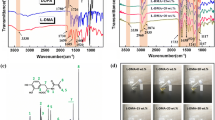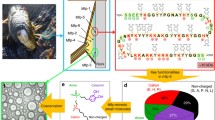Abstract
Direct deployment of gluing and achieving durable robust adhesion in water is challenging due to difficulty in repelling interface water. This work reports a novel hyperbranched polymer-based water-resistant adhesive (HBPBA) based on Michael addition reaction of multi-vinyl monomers with dopamine and 3-aminophenylboronic acid. Upon encountering water, the HBPBA forms coacervates whose hydrophobic chains aggregate to displace interface water, and meanwhile the catechols exposing outwards contribute to underwater adhesion. The HBPBA can strongly glue diverse substrates including PTFE, PE, PET, ceramic, Ti and stainless steel. The HBPBA can maintain stable adhesion in different environments, such as tap water, simulated sea water, PBS, and a wide range of pH solutions (pH 2 to 10) for 3 months, supposedly due to the complexation of catechol with boronic acid. Intriguingly, HBPBA film can be bonded to the titanium surface as a primer, which firmly anchors the antifouling PNAGA-PCBAA hydrogel coating through copolymerization of remaining double bonds in HBPBA and NAGA plus CBAA. The PNAGA-PCBAA hydrogel-modified titanium is biocompatible and shows outstanding antifouling ability both in vitro and in vivo. This work proposes a new strategy for creating underwater deployable and water-resistant adhesives that may find promising applications in engineering and biomedical fields.
Similar content being viewed by others
References
Di Bella G, Galtieri G, Pollicino E, et al. Mechanical characterization of adhesive joints with dissimilar substrates for marine applications. Int J Adhes Adhes, 2013, 41: 33–40
Sapronov O, Maruschak P, Sotsenko V, et al. Development and use of new polymer adhesives for the restoration of marine equipment units. J Marine Sci Eng, 2020, 8: 527
Wang C, Zhang L, Chen M, et al. Application of medical adhesive in emergency treatment of head and face injury. J Craniofac Surg, 2021, 32: 1022–1024
Chen J, Yuan T, Liu Z. Supramolecular medical antibacterial tissue adhesive prepared based on natural small molecules. Biomater Sci, 2020, 8: 6235–6245
Huang D, Huang M, Sun D, et al. Selective metallization of glass with improved adhesive layer and optional hydrophobic surface. Colloids Surfs A-Physicochem Eng Aspects, 2021, 616: 126339
Horkavcová D, Doubet Q, Lecomte-Nana G L, et al. Development of adhesive, bioactive and antibacterial titania sol-gel coating on titanium substrate by dip-coating technique. Coatings, 2021, 11: 243
Zhao Y, Wu Y, Wang L, et al. Bio-inspired reversible underwater adhesive. Nat Commun, 2017, 8: 2218
Hofman A H, van Hees I A, Yang J, et al. Bioinspired underwater adhesives by using the supramolecular toolbox. Adv Mater, 2018, 30: 1704640
Ditsche P, Summers A P. Aquatic versus terrestrial attachment: water makes a difference. Beilstein J Nanotechnol, 2014, 5: 2424–2439
Meredith H J, Jenkins C L, Wilker J J. Enhancing the adhesion of a biomimetic polymer yields performance rivaling commercial glues. Adv Funct Mater, 2014, 24: 3259–3267
Waite J H. Mussel adhesion-essential footwork. J Exp Biol, 2017, 220: 517–530
Zhang X, Liu X, Zeng L, et al. Barnacle adhesion: From substrate detection to cement curing. Prog Biophys Biophys Chem, 2017, 44: 204–214
Scott A R. Polymers: Secrets from the deep sea. Nature, 2015, 519: S12–S13
Shafiq Z, Cui J, Pastor-Pérez L, et al. Bioinspired underwater bonding and debonding on demand. Angew Chem Int Ed, 2012, 51: 4332–4335
Hofman, Hees V, Yang J, et al. Bioinspired underwater dhesives by using the supramolecular toolbox. Adv Mater, 2018, 30: 1704640
Degen G D, Stow P R, Lewis R B, et al. Impact of molecular architecture and adsorption density on adhesion of mussel-inspired surface primers with catechol-cation synergy. J Am Chem Soc, 2019, 141: 18673–18681
Pinnaratip R, Bhuiyan M S A, Meyers K, et al. Multifunctional biomedical adhesives. Adv Healthcare Mater, 2019, 8: 1801568
Peng Q, Chen J, Zeng Z, et al. Adhesive coacervates driven by hydrogen-bonding interaction. Small, 2020, 16: 2004132
Dompé M, Cedano-Serrano F J, Heckert O, et al. Thermoresponsive complex coacervate-based underwater adhesive. Adv Mater, 2019, 31: 1808179
Cui C, Fan C, Wu Y, et al. Water-triggered hyperbranched polymer universal adhesives: From strong underwater adhesion to rapid sealing hemostasis. Adv Mater, 2019, 31: 1905761
Narkar A R, Barker B, Clisch M, et al. pH responsive and oxidation resistant wet adhesive based on reversible catechol-boronate complexation. Chem Mater, 2016, 28: 5432–5439
Dai X, Zhang Y, Gao L, et al. A mechanically strong, highly stable, thermoplastic, and self-healable supramolecular polymer hydrogel. Adv Mater, 2015, 27: 3566–3571
Zhang Z, Vaisocherová H, Cheng G, et al. Nonfouling behavior of Polycarboxybetaine-Grafted surfaces: Structural and environmental effects. Biomacromolecules, 2008, 9: 2686–2692
Stewart R J, Ransom T C, Hlady V. Natural underwater adhesives. J Polym Sci B Polym Phys, 2011, 49: 757–771
Xu Z, Fan C, Zhang Q, et al. A self-thickening and self-strengthening strategy for 3D printing high-strength and antiswelling supramolecular polymer hydrogels as meniscus substitutes. Adv Funct Mater, 2021, 31: 2100462
Chen X, Cui C, Liu Y, et al. A robust poly(N-acryloyl-2-glycine)-based sponge for rapid hemostasis. Biomater Sci, 2020, 8: 3760–3771
Wang H, Wu Y, Cui C, et al. Antifouling super water absorbent supramolecular polymer hydrogel as an artificial vitreous Body. Adv Sci, 2018, 5: 1800711
Liang S, Zhang Y, Wang H, et al. Paintable and rapidly bondable conductive hydrogels as therapeutic cardiac patches. Adv Mater, 2018, 30: 1704235
Zhang Z, Gao Z, Wang Y, et al. Eco-friendly, self-healing hydrogels for adhesive and elastic strain sensors, circuit repairing, and flexible electronic devices. Macromolecules, 2019, 52: 2531–2541
Ji X, Ahmed M, Long L, et al. Adhesive supramolecular polymeric materials constructed from macrocycle-based host-guest interactions. Chem Soc Rev, 2019, 48: 2682–2697
Veiseh O, Doloff J C, Ma M, et al. Size- and shape-dependent foreign body immune response to materials implanted in rodents and nonhuman primates. Nat Mater, 2015, 14: 643–651
Narayanan A, Kaur S, Peng C, et al. Viscosity attunes the adhesion of bioinspired low modulus polyester adhesive sealants to wet tissues. Biomacromolecules, 2019, 20: 2577–2586
Xu Y, Liu Q, Narayanan A, et al. Mussel-inspired polyesters with aliphatic pendant groups demonstrate the importance of hydrophobicity in underwater adhesion. Adv Mater Interfaces, 2017, 4: 1700506
Yang J, Bai R, Chen B, et al. Hydrogel adhesion: A supramolecular synergy of chemistry, topology, and mechanics. Adv Funct Mater, 2020, 30: 1901693
Yang J, Bai R, Suo Z. Topological adhesion of wet materials. Adv Mater, 2018, 30: 1800671
Kan Y, Danner E W, Israelachvili J N, et al. Boronate complex formation with dopa containing mussel adhesive protein retards pH-induced oxidation and enables adhesion to mica. PLoS ONE, 2014, 9: e108869
Giselbrecht S, Rapp B E, Niemeyer C M. The chemistry of cyborgs-Interfacing technical devices with organisms. Angew Chem Int Ed, 2013, 52: 13942–13957
Kornowski R, Hong M K, Tio F O, et al. In-stent restenosis: Contributions of inflammatory responses and arterial injury to neointimal hyperplasia. J Am College Cardiology, 1998, 31: 224–230
Hasan J, Crawford R J, Ivanova E P. Antibacterial surfaces: the quest for a new generation of biomaterials. Trends Biotech, 2013, 31: 295–304
Guo S, Zhu X, Loh X J. Controlling cell adhesion using layer-by-layer approaches for biomedical applications. Mater Sci Eng-C, 2017, 70: 1163–1175
Yang W, Zhou F. Polymer brushes for antibiofouling and lubrication. BioSurf BioTribol, 2017, 3: 97–114
Prucker O, Brandstetter T, Rühe J. Surface-attached hydrogel coatings via C,H-insertion crosslinking for biomedical and bioanalytical applications (Review). Biointerphases, 2017, 13: 010801
Li J, Celiz A D, Yang J, et al. Tough adhesives for diverse wet surfaces. Science, 2017, 357: 378–381
Saha S, Kumar R, Pramanik K, et al. Interaction of osteoblast-TiO2 nanotubes in vitro: The combinatorial effect of surface topography and other physico-chemical factors governs the cell fate. Appl Surf Sci, 2018, 449: 152–165
Aguiari P, Iop L, Favaretto F, et al. In vitro comparative assessment of decellularized bovine pericardial patches and commercial bioprosthetic heart valves. Biomed Mater, 2017, 12: 015021
Author information
Authors and Affiliations
Corresponding author
Additional information
This work was supported by the National Key Research and Development Program (Grant No. 2018YFA0703100), and the National Natural Science Foundation of China (Grant No. 51733006).
Supporting Information
The supporting information is available online at https://tech.scichina.com and https://link.springer.com. The supporting materials are published as submitted, without typesetting or editing. The responsibility for scientific accuracy and content remains entirely with the authors.
Supporting information
11431_2021_1850_MOESM1_ESM.doc
A Hyperbranched Polymer-based Water-resistant Adhesive: Durable Underwater Adhesion and Primer for Anchoring Anti-fouling Hydrogel Coating
Rights and permissions
About this article
Cite this article
Zhang, Y., Cui, C., Sun, Y. et al. A hyperbranched polymer-based water-resistant adhesive: Durable underwater adhesion and primer for anchoring anti-fouling hydrogel coating. Sci. China Technol. Sci. 65, 201–213 (2022). https://doi.org/10.1007/s11431-021-1850-7
Received:
Accepted:
Published:
Issue Date:
DOI: https://doi.org/10.1007/s11431-021-1850-7




